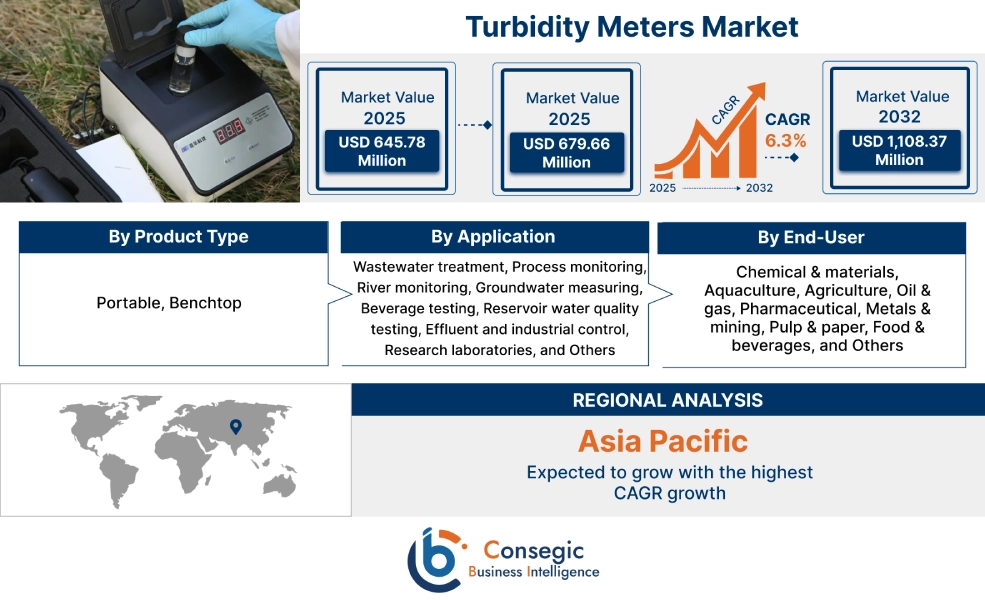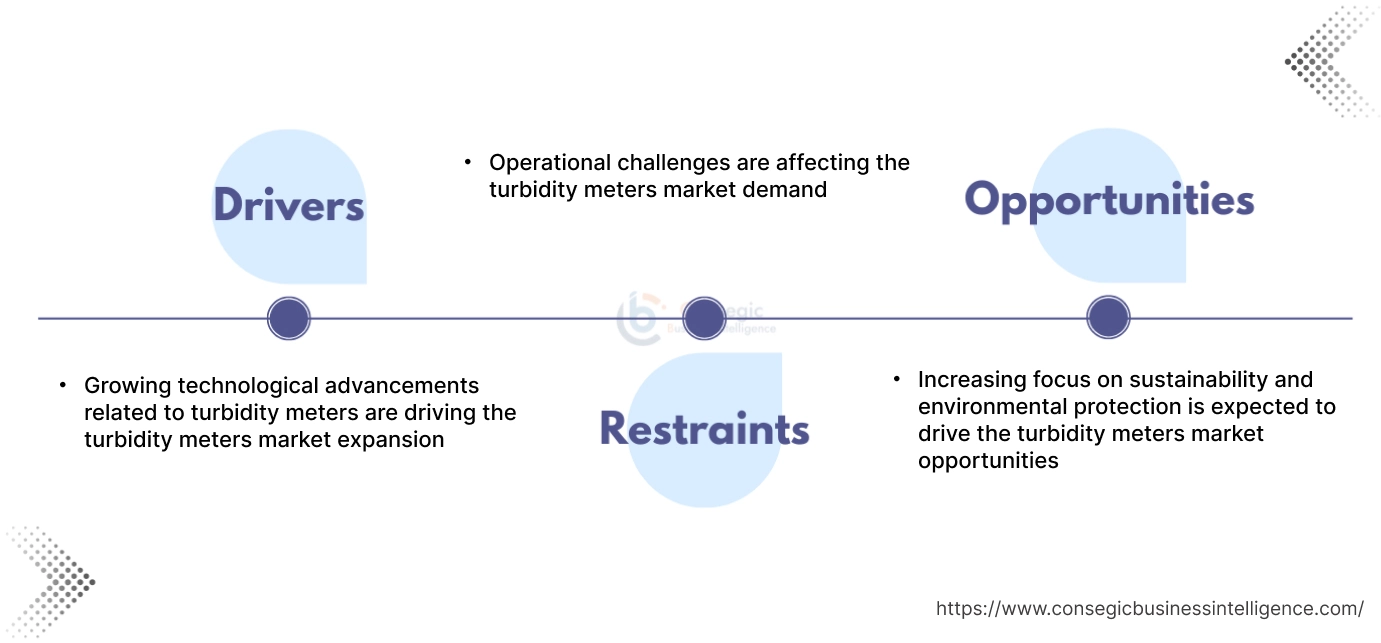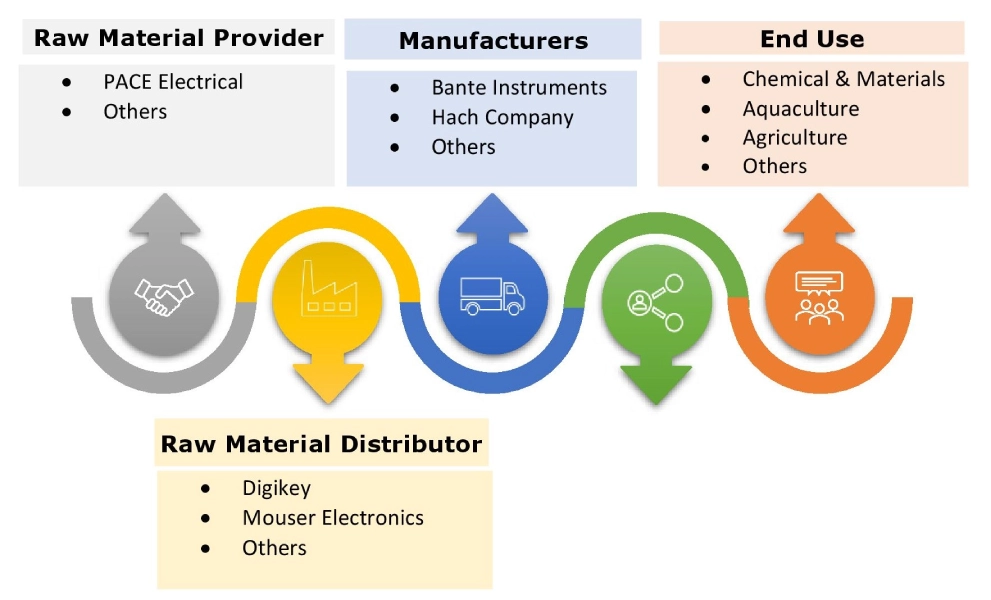Turbidity Meters Market Size:
Turbidity Meters Market Size is estimated to reach over USD 1,108.37 Million by 2032 from a value of USD 645.78 Million in 2024 and is projected to grow by USD 679.66 Million in 2025, growing at a CAGR of 6.3% from 2025 to 2032.
Turbidity Meters Market Scope & Overview:
A turbidity meter is a device that measures the cloudiness or haziness of a fluid caused by suspended particles. These instruments quantify the amount of light blocked or scattered by these particles, providing a numerical value for the turbidity. This value, often expressed in nephelometric turbidity units (NTU) or formazin turbidity units (FTU), indicates how turbid or cloudy the water is. It is used in several applications involving wastewater treatment, process monitoring, river monitoring, groundwater measuring, and other related applications.
How is AI Transforming the Turbidity Meters Market?
There is an emerging use of AI in the turbidity meters market, specifically for facilitating real-time data analytics, automated calibration, and adaptive sensing to improve accuracy, reduce human error, and enhance user efficiency. AI-driven systems can provide actionable insights, facilitate proactive water quality management, and assist in meeting stricter regulatory requirements by transforming raw sensor data into intelligent, connected ecosystems for faster decision-making. Moreover, AI-driven systems can automate the calibration process and perform self-diagnostics, ensuring consistent accuracy and reducing manual intervention. Thus, the above factors are anticipated to boost the market growth in upcoming years.
Turbidity Meters Market Dynamics - (DRO) :
Key Drivers:
Growing technological advancements related to turbidity meters are driving the turbidity meters market expansion
Technological advancements in turbidimeters have led to the development of more sophisticated and efficient devices. For instance, the integration of digital technologies and internet of things (IoT) in turbidimeters has enabled real-time data transmission, remote monitoring, and automated reporting. These advancements are expected to enhance the performance and usability of turbidimeters, thereby driving market growth. Additionally, the growing adoption of smart water management systems is anticipated to create new prospects for in-line turbidimeters.
Companies are focusing on developing advanced turbidimeters with enhanced features such as real-time monitoring, wireless connectivity, and improved accuracy. These technological advancements are not only making turbidimeters more efficient but also broadening their application scope. The integration of digital technologies and IoT in turbidimeters is anticipated to create new prospects in the market.
- For instance, BOQU Instrument’s IoT turbidity sensors are utilized across several industries. Further, integrating IoT technology enables turbidity sensors to link with cloud platforms, facilitating real-time monitoring and data analysis.
Thus, according to the turbidity meters market analysis, the growing technological advancements are driving the turbidity meters market size and growth.
Key Restraints:
Operational challenges are affecting the turbidity meters market demand
Many regions, particularly in developing countries, lack the necessary technological infrastructure for robust water quality monitoring. This includes inadequate sensor networks, data management systems, and skilled personnel to operate and maintain these technologies. Ensuring the accuracy and reliability of water quality data is crucial but often challenging.
Moreover, factors such as sensor calibration drift, environmental factors affecting sensor readings, and inconsistent sampling methods can lead to data inaccuracies, making it difficult to make informed decisions. Compliance with stringent water quality standards and regulations poses significant challenges. Additionally, different regions have varying regulatory frameworks, making it complex for monitoring agencies and water utilities to adhere to standards consistently. Thus, the aforementioned factors would further impact the turbidity meters market size.
Future Opportunities :
Increasing focus on sustainability and environmental protection is expected to drive the turbidity meters market opportunities
The growing awareness about environmental conservation and the need for sustainable practices are driving the need for water quality monitoring devices, including turbidimeters. Government initiatives and funding for environmental protection projects are expected to create new prospects for market players. Moreover, the increasing emphasis on corporate social responsibility (CSR) and the adoption of sustainable practices by industries are anticipated to boost the need for turbidimeters. Market players can take advantage of these prospects by offering eco-friendly and sustainable solutions.
- For instance, Yokogawa’s total wastewater management system provides SMART and comprehensive solutions for water treatment plants, with turbidity, total chlorine, free chlorine, pH, and conductivity measurement technology. Yokogawa is prioritizing its digital SMART Sensor SENCOM 4.0 platform to optimize processes and boost staff efficiency. This advanced analyzer platform offers comprehensive visibility and increases operational uptime by streamlining maintenance, cutting down configuration time, and simplifying in-field servicing and calibration.
Thus, based on the above turbidity meters market analysis, the increasing focus on sustainability and environmental protection is expected to drive the turbidity meters market opportunities.
Turbidity Meters Market Segmental Analysis :
By Product Type:
Based on product type, the market is segmented into portable and benchtop.
Trends in the product type:
- The increasing automation in industrial processes and the need for efficient water management solutions are propelling the need for turbidity measurement tools.
- The rise in research and development activities in academic institutions and research laboratories is contributing to the segment development.
- Thus, based on the above analysis, these factors are driving the turbidity meters market demand.
The portable segment accounted for the largest revenue share in the year 2024.
- Portable turbidity measurement tools are gaining significant traction due to their convenience, ease of use, and ability to provide quick and reliable measurements on-site.
- These devices are particularly useful for field applications where immediate water quality assessment is required.
- The growing need for real-time monitoring and the increasing adoption of portable devices in environmental monitoring and industrial applications are driving the need for portable turbidity measurement tools.
- Moreover, the rising need for portable turbidimeters is driven by the need for immediate and accurate water quality assessments in remote and inaccessible areas.
- For instance, La Motte’s 2020i portable turbidity meter is designed for precision and accurate testing. The instrument uses different measurement modes for various turbidity levels, which cover 0-40 NTU/FNU and handle 40-1000 NTRU/FNRU.
- Thus, based on the above analysis, these factors are further driving the turbidity meters market growth and trends.
The benchtop segment is anticipated to register the fastest CAGR during the forecast period.
- Benchtop meters are preferred for their high accuracy and advanced features, making them suitable for laboratory settings. These devices are extensively used in research laboratories, academic institutions, and industrial labs where precise and detailed turbidity measurements are essential.
- The advancements in benchtop turbidity meter technology, such as the integration of sophisticated sensors, data logging capabilities, and user-friendly interfaces, are enhancing their adoption in various scientific and industrial applications.
- The increasing focus on quality control and compliance with regulatory standards in industries such as pharmaceuticals, food and beverage, and water treatment is also contributing to the growth of the benchtop turbidity meters segment.
- Thus, based on the above analysis, these factors are expected to drive the turbidity meters market share and growth during the forecast period.
By Application:
Based on the application, the turbidity meters market is segmented into wastewater treatment, process monitoring, river monitoring, groundwater measuring, beverage testing, reservoir water quality testing, effluent and industrial control, research laboratories, and others.
Trends in the application:
- The versatility of turbidity meters and their ability to provide precise and reliable data make them significant tools in a wide range of applications.
- Technological advancements and the integration of digital technologies are anticipated to further enhance the performance and usability of turbidimeters, creating new prospects in the market.
The wastewater treatment segment accounted for the largest revenue share of 25.57% in the year 2024.
- The water and wastewater treatment segment holds a significant share of the market due to the increasing need for monitoring water quality and ensuring the safety of water supplies.
- The growing concerns about water scarcity and pollution, coupled with stringent regulations, are driving the need for turbidimeters in the wastewater treatment.
- The growing emphasis on providing safe drinking water and treating wastewater effectively is driving the need for turbidity meters in this application segment.
- For instance, in February 2021, Yokogawa Electric Corporation announced the addition of TB820D turbidity detector, FC800D non-reagent free available chlorine sensor, RC800D reagent residual chlorine sensor, FLXA402T liquid analyzer (for both turbidity and chlorine), and PG400 pulse generator for water treatment facilities. These additions will make Japan's high-quality water purification technology accessible to countries in Southeast Asia, the Middle East, South Korea, Australia, and Taiwan.
- Thus, based on the above analysis, these factors would further supplement the turbidity meters market share and trends.
The beverage testing segment is anticipated to register the fastest CAGR during the forecast period.
- In beverage testing, turbidimeters are used to ensure the quality and safety of products by detecting contamination and particulate matter.
- The stringent quality standards and regulations in the food and beverage sector necessitate the use of reliable turbidity measurement tools.
- The growing consumer need for high-quality and safe food and beverage products is driving manufacturers to invest in advanced turbidity meters, thereby propelling the segment growth.
- The continuous advancements in technology, such as the development of more accurate and user-friendly devices, are further enhancing the adoption of turbidimeters in the food and beverage industry.
- These developments in the segment are anticipated to further drive the turbidity meters market trends during the forecast period.
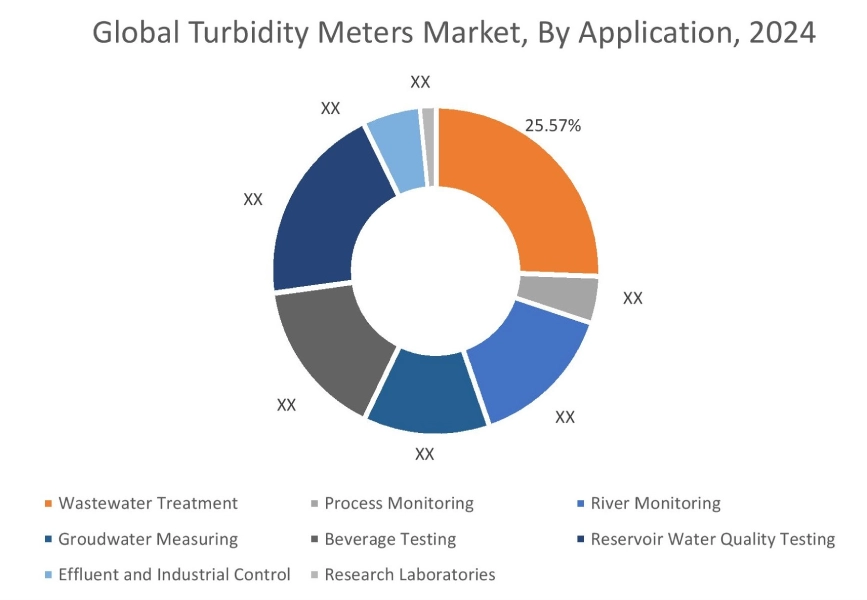
By End User:
Based on end user, the turbidity meters market is segmented into chemical & materials, aquaculture, agriculture, oil & gas, pharmaceutical, metals & mining, pulp & paper, food & beverages, and others.
Trends in the end user:
- The growing emphasis on environmental conservation and the need to comply with environmental regulations are driving the adoption of turbidity measurement tools in this segment.
- Industrial end-users encompass various industries such as pharmaceuticals, food and beverages, chemicals, and manufacturing. These industries require high-quality water for their operations and must adhere to strict regulatory standards. The increasing focus on quality assurance and regulatory compliance in these industries is propelling the demand for turbidity measurement tools.
The aquaculture segment accounted for the largest revenue share in the year 2024.
- The increasing focus on sustainable aquaculture practices requires accurate and reliable water quality monitoring to minimize environmental impact and ensure fish health.
- The regulations related to water quality in aquaculture are becoming stricter, leading to increased adoption of turbidity measurement tools for compliance.
- The innovations in sensor technology, automation, and wireless communication are driving the development of more sophisticated and efficient turbidity measurement tools.
- Therefore, the above factors are driving the turbidity meters market growth and trends.
The food and beverage segment is anticipated to register the fastest CAGR during the forecast period.
- Consumers and regulatory bodies are increasingly demanding higher quality and consistency in food and beverage products, driving the need for precise monitoring tools.
- These devices help in monitoring the clarity and purity of water used in food and beverage production, as well as detecting any contamination in the final products.
- The increasing focus on food safety and quality standards is expected to drive the demand for turbidimeters in the food and beverage industry.
- These factors are anticipated to further drive the turbidity meters market trends during the forecast period.
Regional Analysis:
The global market has been classified by region into North America, Europe, Asia-Pacific, Middle East & Africa, and Latin America.
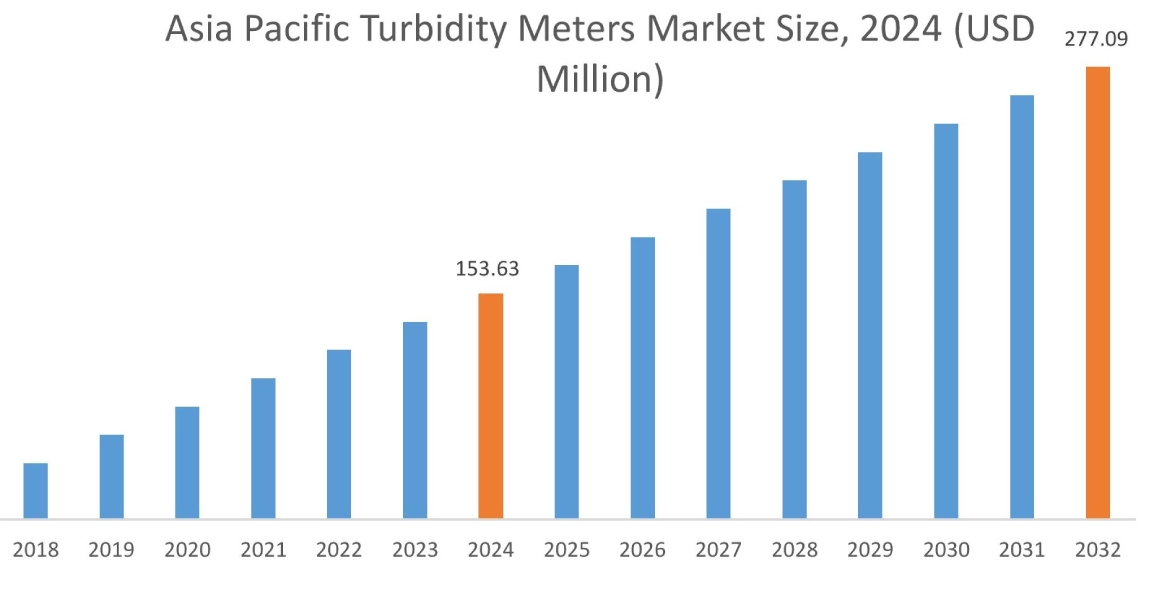
Asia Pacific turbidity meters market expansion is estimated to reach over USD 277.09 million by 2032 from a value of USD 153.63 million in 2024 and is projected to grow by USD 162.38 million in 2025. Out of this, the China market accounted for the maximum revenue split of 32.45%. The Asia-Pacific region is experiencing rapid industrialization and urbanization, leading to heightened concerns over water pollution. Governments in the region are prioritizing investments in water quality monitoring infrastructure to safeguard public health and support sustainable development goals. Further, emerging economies in the region are adopting affordable sensor technologies and leveraging big data analytics to manage water resources effectively. These trends would further drive the regional turbidity meters market during the forecast period.
- For instance, Yokogawa’s TB830D surface scattering light turbidity detector is a high-performance instrument designed for critical turbidity measurements in various water treatment and industrial applications. As part of Yokogawa's OpreX Analyzers lineup and the SENCOM 4.0 Platform, it offers advanced features for reliable, low-maintenance operation. It also supports remote monitoring of measurement information and equipment information.
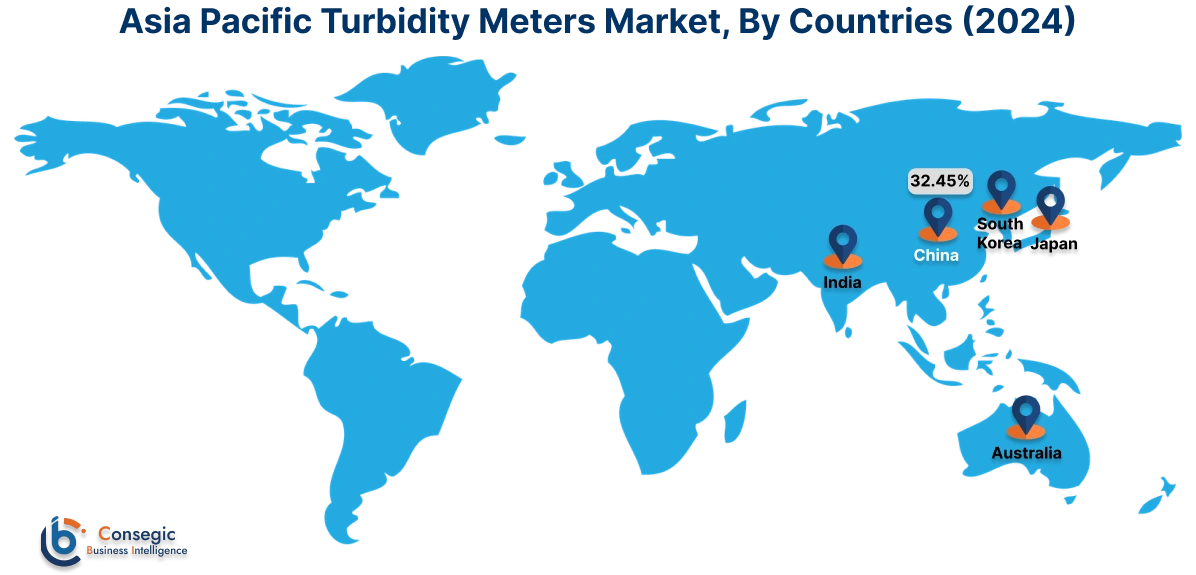
North America market is estimated to reach over USD 405.00 million by 2032 from a value of USD 237.27 million in 2024 and is projected to grow by USD 249.60 million in 2025. The growing awareness about environmental conservation and the need for sustainable practices are driving the need for water quality monitoring devices among several end-user industries in the region. Further, government initiatives and funding for environmental protection projects are expected to create new opportunities for market players. Moreover, the increasing emphasis on corporate social responsibility (CSR) and the adoption of sustainable practices by industries are anticipated to boost the demand for turbidity measurement tools. These factors would further drive the market trends in North America.
- For instance, Hach, a U.S.-based company, provides TU52 turbidity measurement tool for drinking water and clean water applications. A core benefit of the TU5 series includes its identical 360° x 90° detection technology, which can be used in both the lab and online instruments.
As per the analysis, the turbidity meters industry in Europe is expected to witness significant development during the forecast period. The growing investments in research and development activities and the stringent quality standards in various industries are driving the demand for turbidity meters in Europe. Additionally, the presence of advanced research infrastructure and the growing number of research projects related to environmental sciences and industrial applications are further contributing to the Latin American market growth. Further, governments in the Middle East & Africa region are investing in monitoring systems to mitigate pollution risks and ensure water security.
Top Key Players and Market Share Insights:
The global turbidity meters market is highly competitive, with major players providing products to the national and international markets. Key players are adopting several strategies in research and development (R&D), product innovation, and end-user launches to hold a strong position in the market. Key players in the turbidity meters industry include-
- Bante Instruments (China)
- HF Scientific (Watts) (U.S.)
- LaMotte Company (U.S.)
- OMEGA Engineering (U.S.)
- Thermo Fisher Scientific (U.S.)
- DKK-TOA CORPORATION (Japan)
- Endress+Hauser Management AG (Switzerland)
- Extech (FLIR Systems) (U.S.)
- Hach Company (U.S.)
- Hanna Instruments, Inc. (U.S.)
Turbidity Meters Market Report Insights :
| Report Attributes | Report Details |
| Study Timeline | 2019-2032 |
| Market Size in 2032 | USD 1,108.37 Million |
| CAGR (2025-2032) | 6.3% |
| By Product Type |
|
| By Application |
|
| By End User |
|
| By Region |
|
| Key Players |
|
| North America | U.S. Canada Mexico |
| Europe | U.K. Germany France Spain Italy Russia Benelux Rest of Europe |
| APAC | China South Korea Japan India Australia ASEAN Rest of Asia-Pacific |
| Middle East and Africa | GCC Turkey South Africa Rest of MEA |
| LATAM | Brazil Argentina Chile Rest of LATAM |
| Report Coverage |
|
Key Questions Answered in the Report
How big is the Turbidity Meters Market? +
Turbidity Meters market size is estimated to reach over USD 1,108.37 Million by 2032 from a value of USD 645.78 Million in 2024 and is projected to grow by USD 679.66 Million in 2025, growing at a CAGR of 6.3% from 2025 to 2032.
Which is the fastest-growing region in the Turbidity Meters Market? +
Asia-Pacific region is experiencing the most rapid growth in the market.
What specific segmentation details are covered in the Turbidity Meters report? +
The mixing console report includes specific segmentation details for product type, application, end user, and region.
Who are the major players in the Turbidity Meters Market? +
The key participants in the market are Bante Instruments (China), DKK-TOA CORPORATION (Japan), Endress+Hauser Management AG (Switzerland), Extech (FLIR Systems) (U.S.), Hach Company (U.S.), Hanna Instruments, Inc. (U.S.), HF Scientific (Watts) (U.S.), LaMotte Company (U.S.), OMEGA Engineering (U.S.), Thermo Fisher Scientific (U.S.), and others.
